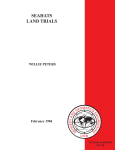Download AirLive BC-5010
Transcript
BC-5010 / BC-5010-IVS 5-Mega Pixel Box Type PoE IP Camera 5-Mega Pixel Box Type PoE IP Camera with Video Analytics User’s Manual Copyright and Disclaimer Copyright & Disclaimer No part of this publication may be reproduced in any form or by any means, whether electronic, mechanical, photocopying, or recording without the written consent of OvisLink Corp. OvisLink Corp. has made the best effort to ensure the accuracy of the information in this user’s guide. However, we are not liable for the inaccuracies or errors in this guide. Please use with caution. All information is subject to change without notice This product contains some codes from GPL. In compliance with GPL agreement, AirLive will publish the GPL codes on our website. Please go to www.airlive.com and go to the "Support->GPL" menu to download source code. All Trademarks are properties of their respective holders. i AirLive BC-5010/BC-5010-IVS User’s Manual Copyright and Disclaimer FCC Statement Federal Communication Commission Interference Statement This equipment has been tested and found to comply with the limits for a Class B digital device, pursuant to Part 15 of the FCC Rules. These limits are designed to provide reasonable protection against harmful interference in a residential installation. This equipment generates uses and can radiate radio frequency energy and, if not installed and used in accordance with the instructions, may cause harmful interference to radio communications. However, there is no guarantee that interference will not occur in a particular installation. If this equipment does cause harmful interference to radio or television reception, which can be determined by turning the equipment off and on, the A user is encouraged to try to correct the interference by one of the following measures: Reorient or relocate the receiving antenna. Increase the separation between the equipment and receiver. Connect the equipment into an outlet on a circuit different from that to which the receiver is connected. Consult the dealer or an experienced radio/TV technician for help. FCC Caution Any changes or modifications not expressly approved by the party responsible for compliance could void the user's authority to operate this equipment. This device complies with Part 15 of the FCC Rules. Operation is subject to the following two conditions: (1) This device may not cause harmful interference, and (2) this device must accept any interference received, including interference that may cause undesired operation. For product available in the USA/Canada market, only channel 1~11 can be operated. Selection of other channels is not possible. This device and its antenna(s) must not be co-located or operation in conjunction with any other antenna or transmitter. FCC Radiation Exposure Statement This equipment complies with FCC radiation exposure limits set forth for an uncontrolled environment. This equipment should be installed and operated with minimum distance 20cm between the radiator & your body. WEEE Marking Warning: The crossed out wheeled bin indicates the product must not be disposed together with household waste. For the sake of the environment, the product should only be given to entities involved in the reception of waste electronic and electrical equipment. The lists of entities entitled to receive used equipment can be found on the websites of municipalities. Some components of devices such as external wiring, circuit boards and liquid crystal displays have a negative impact on the environment. AirLive BC-5010/BC-5010-IVS User’s Manual ii Table of Contents Table of Contents 1. Overview .....................................................................................................1 1.1 Introduction ..........................................................................................1 1.2 Features...............................................................................................2 1.3 Product Specification ...........................................................................2 1.4 System Requirement ...........................................................................5 2. Package Contents and Installation...........................................................6 2.1 Package Content .................................................................................6 2.2 Connections .........................................................................................7 2.3 Connections Mounting the Camera .....................................................9 2.4 Connect USB dongle for wireless function (Optional)........................13 2.5 Connect to IP Camera .......................................................................13 3. Using IP Camera via Web Browser.........................................................15 3.1 Windows Web Browser......................................................................15 4. Operating IP Camera via Mobile Phone .................................................17 4.1 Using IP Camera via iPhone..............................................................17 5. Configuration of Main Menu....................................................................19 5.1 Live View............................................................................................20 5.2 Configuration .....................................................................................21 6. Configuration-Network ............................................................................23 6.1 General ..............................................................................................24 6.2 UPnP/Bonjour/QoS ............................................................................26 6.3 IP Filter...............................................................................................27 6.4 IP Notification.....................................................................................28 6.5 iSCSI..................................................................................................29 6.6 Wireless .............................................................................................29 7. Video Settings ..........................................................................................31 7.1 Video Profile.......................................................................................32 iii AirLive BC-5010/BC-5010-IVS User’s Manual Table of Contents 7.2 Exposure............................................................................................32 7.3 Image.................................................................................................34 7.4 WDR ..................................................................................................35 7.5 Overlay ..............................................................................................36 8. Audio.........................................................................................................37 8.1 Audio Setting......................................................................................37 9. Event .........................................................................................................38 9.1 Event..................................................................................................38 9.2 Event Schedule..................................................................................40 9.3 Motion Detection ................................................................................41 9.4 Tamper Detection...............................................................................42 10. RS-485.....................................................................................................43 10.1 RS-485 Settings...............................................................................44 10.2 RS-485 PTZ .....................................................................................44 11. System ....................................................................................................45 11.1 Device Settings ................................................................................46 11.2 Account ............................................................................................46 11.3 Management Ports...........................................................................48 11.4 Firmware ..........................................................................................48 11.5 Maintenance.....................................................................................49 12. Status ......................................................................................................50 12.1 Basic ................................................................................................50 12.2 Audio/Video......................................................................................50 12.3 Network............................................................................................51 12.4 System Log ......................................................................................52 13. Video Analytics ......................................................................................53 13.1 Video Analytics (Only for BC-5010-IVS) ..........................................53 14. Appendix.................................................................................................61 A. Alarm I/O Connector ............................................................................61 AirLive BC-5010/BC-5010-IVS User’s Manual iv 1. Overview 1 1. Overview This user’s guide explains how to operate this camera from a computer. User should read this manual completely and carefully before you operate the device. 1.1 Introduction AirLive BC-5010 / BC-5010-IVS is a standalone system that can be connected directly to an Ethernet or Fast Ethernet network. Equipped with a powerful 5 megapixel color CMOS sensor, the camera allows you to capture a wider field of view with high resolution up to 2592 x 1920. With supporting of latest H.264 technology, you can record the video streaming that utilizes with high quality H.264 images to any external storages, enables motion detection and automatic e-mail alerts for security. The camera supports external DC-Iris lens. It also provides the power and control signals which is required to adjust the DC-lris. The DC-Iris connector (4-pin) is on the side panel of the camera. You can attach any standard DC-Iris lens for specific use, such as outdoor applications with water-proof enclosure. In addition, the camera can attach a variety of external devices for your specific purposes through the GPIO connectors. BC-5010 / BC-5010-IVS features web-based solutions that can provide a cost-effective solution to transmit the real-time high-quality video images and sounds synchronously for monitoring. This camera can be managed remotely, so that you can use a web browser to access and control it from any desktop/notebook computer over the Intranet or Internet. With IEEE802.3af PoE (Power over Ethernet) standard, the camera provides you more flexibility of camera installation according to your application. The camera can be powered by the Ethernet, so that you can place the camera anywhere without a power outlet support. Note: Lens is not included in the product package. 1 AirLive BC-5010/BC-5010-IVS User’s Manual 1. Overview 1.2 Features This manual will illustrate the steps of how to setup and operate this IP camera, so you’ll also soon be enjoying the benefits of these product features: 5 megapixel high resolution CMOS sensor 0.2Lux at F1.2 DC IRIS and IR-CUT Removable (ICR) Multiple Profiles Supported(H.264, MPEG4, MJPEG and 3GPP) Support 15fps at 2592x1920 Two-way audio Intelligent motion detection up to 3 zones Support iSCSI, WDR enhanced HTTP/RTSP protocols selectable Image transmission using an FTP or e-mail for event Digital I/O connectors and RS-485 supported 802.3af PoE support USB wireless dongle support (with adaptor only) SD/SDHC Slot and USB slot for local storage Compatible with ONVIF standard Built-in Video Analytics (Equipped only for BC-5010-IVS) UPnP device discovery and NAT router transversal for easy installation Dynamic IP Service, DIPS®, to search your IP camera from Internet easily 1.3 Product Specification Model Camera BC-5010/BC-5010-IVS Camera Type Image Sensor Sensor Resolution Night Vision Max IR Distance Indoor Box Type 1/2.5” 5 megapixel CMOS Sensor 2592 X 1920 C/CS Mount Lens Support Removable Lens Built-In Removable IR Cut Filter None Min. Illumination 0.2 LUX Lens Type AirLive BC-5010/BC-5010-IVS User’s Manual 2 1. Overview Mechanical IR-Cut Yes Filter Auto Iris DC-Iris Support Viewing Angle Depend on lens Pan/Tile Control None Analog Video Out Yes Video Compression H.264 High/Main/Baseline Profile, MPEG4 Simple Profile and MJPEG Video Profile Video Audio Network Yes 15 fps @ 2592 X 1920 25 fps @ 2048 x 1536 30 fps @ 1920 x1080 30 fps @ 1280 x 1024 Resolution and 30 fps @ 1280 x960 Frame Rate 30 fps @ 1280 x 720 30 fps @ 720 x 480 30 fps @ 640 x 480 30 fps @ 320 x 240 30 fps @ 176 x 144 Multi-profile streaming Streaming over UDP, TCP, or HTTP MJPEG streaming over HTTP (for non IE browser) Streaming 3GPP mobile view Configurable frame rate and bandwidth Support both CBR and VBR ROI Yes AE, AWB Saturation, brightness, sharpness, contrast, Hue Image Processing Mirror/Flip Text, time and date OSD Digital Zoom 10X G711 u-law Audio Encoder AMR Audio Streaming Two-way Audio Input/Output speaker port and microphone port Ethernet One RJ45 Port; IEEE 802.3u Compliant 10/100 Mbps Fast Ethernet with Auto-MDIX 3 AirLive BC-5010/BC-5010-IVS User’s Manual 1. Overview PoE Wireless IEEE802.3af Optional TCP/IP,IPV6, UDP, ICMP, DHCP, NTP, DNS, DDNS, Supported Protocols SMTP, FTP, HTTP, HTTPs, Samba, PPPoE, UPnP, Bonjour, RTP, RTSP, RTCP, DLNA, ONVIF, ISCSI Password protection Security IP filter HTTPS Users Up to 20 simultaneous users Power LED Amber Color LED and Link/Act. LED Green Color Button Reboot and Factory Default Reset Button (Push and Hold Over 5 Sec) Network Processor DSP Base System ROM 128MByte NAND Flash System RAM 128Mbyte DDR2 SDRAM Power Supply DC12V Power Consumption 4 Watts Max. RJ-45 10BaseT/100BaseTX 12V DC power jack Connector Microphone/Speaker jack General DIDO Reset button Environment SD card slot Dimension System Integration Software Event Triggers Motion Detection Event handler Operation: Temp: -5℃ ~ 55℃ Humidity: 20% ~ 85% non-condensing Storage: Temp: -15℃ ~ 60℃ Humidity: 0% ~ 90% non-condensing SD/SDHC 135 * 65 * 65 mm CamPro Express 64,CamPro Professional Search & Installation- IP Wizard II Motion detection External input via DI interface 3 FTP or NAS file upload E-mail alert HTTP, and TCP notification AirLive BC-5010/BC-5010-IVS User’s Manual 4 1. Overview UPNP Application Programming Interface Video Buffer Alarm Events Continuous recording OS Viewing System DO (digital output) alarm SD/USB file upload Yes ONVIF 2.2 Open API for software integration SDK Pre- and post- alarm buffering File upload via FTP or email Notification via email, HTTP, and TCP External output activation Save to SD card/USB Yes Windows® XP, Vista, 7, 8 IE 7.0 or later, Firefox 2.0 or later, Safari, Google Chrome With 3GPP player, CamPro Mobile for iOS/Android device VLC, Quick Time, Real Player, Core Player Browser Cell Phone Video Player 1.4 System Requirement For normal operation and viewing of the network camera, it’s recommended that your system meets these minimum requirements for proper operation: Item Requirements CPU Pentium-4 2.0 GHz or higher VGA Monitor Resolution1280 x 1024 or higher RAM 1 GB or more Operating System Windows XP, Vista, 7, 8 Web Browser Internet Explorer 7 or later; Apple Safari 2 or above; Firefox 2.00 or above; Google Chrome Note: Please keep updating the latest Windows software and service package. (Ex: Net Framework, Windows Media Player, Enhance ActiveX Security 5 AirLive BC-5010/BC-5010-IVS User’s Manual 2. Package Contents and Installation 2 2. Package Contents and Installation 2.1 Package Content A user can find the following items in the package as below: 1. AirLive BC-5010/BC-5010-IVS is the main part of the product with Camera Mount Kit. Note: The lens is optional. For further information about the lens, please contact with your installer. 2. Power Adapter: DC 12V/1A 3. User’s Manual CD provides installation software, application program, important information and instructions for operating the Network Camera. 4. Quick Setup Guide provides important information and instructions for installing this device. If any of the above items are missing, please contact your dealer immediately. Note: 1.) Using a power supply with a different voltage than the one included with the Network Camera will cause damage and void the warranty for this product. 2.) This product does not come with lens. It is optional. AirLive BC-5010/BC-5010-IVS User’s Manual 6 2. Package Contents and Installation 2.2 Connections Front / Top / Side Panel 1. DC-iris Connector: It allows you to attach the DC-Iris lens (optional). 2. C and CS Lens Focus Ring: You can adjust C and CS lens focus ring to fit your lens type. Back Panel 7 AirLive BC-5010/BC-5010-IVS User’s Manual 2. Package Contents and Installation 1. RJ45 LAN socket: Connect to PC or Hub/Switch. This Ethernet port built N-Way protocol can detect or negotiate the transmission speed of the network automatically. Please use Category 5 cable to connect the Network Camera to a 100Mbps Fast Ethernet network switch or hub. In the LAN socket, there are two LEDs below: LAN LED (green color) This LED will be flashing while network accessing via Ethernet. Power (orange color) This LED is used to indicate whether DC power is on or not. In addition, this LED will be flashing while the wireless accessing of the Camera. 2. GPIO/RS-485: Connect to a local keyboard controller. DI/ DO: Connect to sensor in and alarm out devices Cable for I/O connectors: PIN SPECIFICATION 1 RS-485 D+ 2 RS-485 D- 3 Ground (Common) GND 4 GPIO Out Close circuit current maximum: 70mA AC or 100mA Output resistance: 30 ohm Open circuit voltage maximum: 240V AC or 350V DC 5 GPIO In #1 6 GPIO In #2 Compliant to RS-485 Action high voltage: 9~40 VDC Dropout voltage: 0 VDC 3. DC-in Jack: The input power is DC 12V/1A. Note that supply the power to the Network Camera with the power adapter included in package. 4. Audio I/O Connectors MIC in (audio in): Connect a microphone to the network camera. Audio out: Connect a loud speaker to the network camera. This function is for voice alerting and two-way audio. 5. Iris Level: It is used only when the DC-Iris lens is connected to the camera. This screw-knob allows you to adjust the brightness of the video images from the DC-Iris lens. AirLive BC-5010/BC-5010-IVS User’s Manual 8 2. Package Contents and Installation 6. SD Card Slot: SD Card Slot allows you to insert a memory card for expansion of storage. 7. USB Port: USB Port connects external USB device, such as flash drive or USB wireless adapter. 8. BNC connector: BNC connector can connect monitor to check camera focus and video quality. 9. Reset Button: This button is used to restore all the factory default settings. Sometimes restarting the device will make the system back to a normal state. However, if the system still has problems after restart, user can restore the factory default settings and install it again. Restore the device: 1.) Press the button down continuously. 2.) Hold the button at least 5 seconds and release it. Then the device has been restored to default settings and reboot again. Note: Restoring to the factory default settings will lose all the previous settings included IP address forever. User needs to run the IP Wizard II program to search the device and configure it to let the device work properly again. 2.3 Connections Mounting the Camera 1. Attaching the Wall Mount Kit The Wall Mount Kit that is provided in the package has a swivel ball screw head, so that you can attach it to the screw hole on the camera’s top (or bottom) panel. After attaching the camera to the Wall Mount Kit, the camera can be mounted on the wall or ceiling securely through the three screw holes on the base of the Wall Mount Kit. Fix the camera to ceiling with the three supplied screws. 9 AirLive BC-5010/BC-5010-IVS User’s Manual 2. Package Contents and Installation 2. Connecting to LAN You can use the provided Ethernet cable to connect the camera to your local area network (LAN). When you connect the AC power adapter, the camera is powered on automatically. You can verify the power status from the Power LED on the Ethernet port. Once connected, the Link LED starts flashing green light and the camera is on standby and ready for use now. AirLive BC-5010/BC-5010-IVS User’s Manual 10 2. Package Contents and Installation 3. Connect the external power supply to Camera Connect the attached power adapter to the DC power jack of the camera. Note: Use the 12VDC power adapter, included in the package, and connect it to wall outlet for AC power. Once you have installed the camera well and powered it on, the power LED (orange) will turn on later. When the power LED turned on, it means that the system is booting up successfully. Furthermore, if you have a proper network connection and access to the camera, the LAN LED (green) will flash. 4. Replacing the Lens Assembly The camera is designed with a CS- mount, allowing you to install any standard C or CS lens that are commonly used in the surveillance application. Installing the Lens Assembly To install new lens assembly, follow the instructions below: 1. Remove the protective cap. 2. Fit the C or CS lens onto the CS-mount ring and screw it in clockwise. 3. Plug the cable to the DC-Iris connector on the side panel of the camera. When you use a DC-Iris lens on your camera, you can adjust the brightness of the video image through the Iris Level screw-know on the back panel of the camera. 11 AirLive BC-5010/BC-5010-IVS User’s Manual 2. Package Contents and Installation C and CS Lens Focus Adjustment You can adjust C and CS lens focus ring to fit your lens type. 5. Applications of the Camera The camera can be applied in multiple applications, including: z Monitor local and remote places and objects via Internet or Intranet. z Capture still images and video clips remotely. z Upload images or send email messages with the still images attached. The following diagram explains one of the typical applications for your camera and provides a basic example for installing the camera. Home Applications of the Internet Camera AirLive BC-5010/BC-5010-IVS User’s Manual 12 2. Package Contents and Installation 2.4 Connect USB dongle for wireless function (Optional) You can add wireless function to your BC-5010 / 5010-IVS by connecting the optional wireless USB dongle. 2.5 Connect to IP Camera 1. Insert the bundle CD into your PC/Laptop. 2. Auto Run Screen then shows up; click “Install Software Æ “IP Wizard II” to install the configuration tool software. 13 AirLive BC-5010/BC-5010-IVS User’s Manual 2. Package Contents and Installation 3. After completing installation, run the configuration tool software. 4. The Software scans the network and finds the IP Camera and then lists them in the dialog box. 5. If the Camera’s IP address is in the same IP segment as your LAN, select the founded IP Camera and double click on the item. Then, the default browser will show up and connect to the IP camera’s Web automatically. AirLive BC-5010/BC-5010-IVS User’s Manual 14 3. Using IP Camera via Web Browser 3 3. Using IP Camera via Web Browser 3.1 Windows Web Browser 1. Open your web browser, and enter the IP address or host name of the IP camera in the Location / Address field of your browser. Note: If you only want to view the video without accessing Setting screen, enter “http://<IP>/index2.htm” as your web URL. 2. Use the default account “admin” and default password “airlive”. Note: The default user name “admin” and the password “airlive” are set at the factory for the administrator. 3. According your browser’s security setting, the IE Web Page may prompt the “Security Warning” window. If so, select “Yes” to install and run the ActiveX control into your PC. Otherwise, the system will load the ActiveX silently. 4. After the ActiveX control was installed and ran, the first image will be displayed. 15 AirLive BC-5010/BC-5010-IVS User’s Manual 3. Using IP Camera via Web Browser 5. The monitor image will be displayed in your browser. In the left side of main configuration is “Configuration”. For more details, you can check the following chapters. AirLive BC-5010/BC-5010-IVS User’s Manual 16 4. Operating IP Camera via Mobile Phone 4 4. Operating IP Camera via Mobile Phone 4.1 Using IP Camera via iPhone You can access into your IP camera via the iOS/Android device. Please follow the setup steps below. 1. Download AirLive CamPro Mobile 2. Execute the AirLive CamPro Mobile program. from APP store/Android market. 4. Setup page appears. 3. Click Setup button. 17 AirLive BC-5010/BC-5010-IVS User’s Manual 4. Operating IP Camera via Mobile Phone 5. Click Add button. 6. Click LAN button and select the camera. AirLive BC-5010/BC-5010-IVS User’s Manual 18 5. Configuration of Main Menu 5 5. Configuration of Main Menu In the left side of main configuration is Configuration. For more details, please check the following Chapters. In the left side, you can control Live View in your main Browser. The functions include Function Buttons, Streaming Protocol, Video Profile, Monitor Image Section, Language and Digital Output. Function Buttons Streaming Protocol Configuration Menu Monitor Image Section Video Profile Language Digital Output 19 AirLive BC-5010/BC-5010-IVS User’s Manual 5. Configuration of Main Menu 5.1 Live View 1. Function Buttons You can use the function buttons to control the camera’s audio, video, and zoom functions. z : Original screen to full Screen z : Full screen to original screen z : Enlarge the image of the camera digitally. z : Reduce the image of the camera digitally. z : Snapshot z : Record video z / : Click to mute/un-mute the microphone of the camera. When it is un-muted, you receive the on-site sound/voice where the camera is installed. NOTE. The button is available only when the microphone function is enabled from Configuration > Audio of Web Configuration. z / : Click to enable/disable the speaker of the camera. When it is enabled, you can broadcast your sound/voice through the camera. NOTE. The button is available only when the speaker function is enabled from Configuration > Audio of Web Configuration. 2. Monitor Image Section The image from BC-5010 / BC-5010-IVS is shown here. 3. Streaming Select to transmit and record the video using H.264 (MPEG4), or MJPEG compression. 4. Video Output User can select proper streaming protocol according to networking environment. 5. Active X Caching The buffer of Active X. If the bandwidth is limited, you can adjust to higher value but the higher value causes more latency. AirLive BC-5010/BC-5010-IVS User’s Manual 20 5. Configuration of Main Menu 6. Language The device can provide multiple languages to meet user’s requirement. 7. Digital Output This IPCAM allows you to trigger on/off the GPIO output manually. 5.2 Configuration This function is only for the Administrator. In the left side of main configuration, you can see Configuration including below. 21 AirLive BC-5010/BC-5010-IVS User’s Manual 5. Configuration of Main Menu Item Network Video Audio Event RS-485 System Status Action The Network menu contains the networking related settings for the camera, such as the IP Setting, DDNS Setting, IP Filter, etc. For more detail information, you can refer to Chapter 6. Configure bit rate and frame rate of video profiles, camera parameters, day & night. For more detail information, you can refer to Chapter 7. Configure audio parameters. For more detail information, you can refer to Chapter 8. Configure the event setting. For more detail information, you can refer to Chapter 9. Configure RS485 Setting. For more detail information, you can refer to Chapter 10. The system menu provides “Devices Settings, Account, Management Ports, Firmware and Maintenance”. For more detail information, you can refer to Chapter 11. The Status menu provides the current status of the camera, including the basic information, audio/video settings, networking configuration, and system logs. For more detail information, you can refer to Chapter 12. AirLive BC-5010/BC-5010-IVS User’s Manual 22 6. Configuration-Network 6 6. Configuration-Network Click the Network to display the sub-menus including General, UPnP/Bonjour/QoS, IP Filter, IP Notification, iSCSI. 23 AirLive BC-5010/BC-5010-IVS User’s Manual 6. Configuration-Network 6.1 General LAN Interface: This field allows you to select the IP address mode and set up the related configuration. The avail options include: DHCP IPv4, DHCP IPv4/IPv6, and Static IPv4/IPv6. - DHCP IPv4: Select this option when your network uses the DHCP server. When the camera starts up, it will be assigned an IP address from the DHCP server automatically. - DHCP IPv4/IPv6: DHCP for IPv6 enables the DHCP server to pass the configuration parameters (e.g. the IPv6 network addressed) to the IPv6 nodes, which offers the capability of automatic allocation of reusable network addresses and additional configuration flexibility. Select this option if your network supports DHCP IPv6 protocol. When the camera starts up, it will be assigned an IP address from the DHCP server automatically. - Static IPv4/IPv6: Select this option to assign the IP address for the camera directly. You can use IP Finder to obtain the related setting values. AirLive BC-5010/BC-5010-IVS User’s Manual 24 6. Configuration-Network IP Address (IPv4/IPv6) Subnet Mask Default Gateway Primary/ Secondary DNS HTTP Port RTSP Port RTP Data Port Enter the IP address of the camera. The default setting is 192.168.1.100. Enter the Subnet Mask of the camera. The default setting is 255.255.255.0. Enter the Default Gateway of the camera. The default setting is 192.168.1.254 DNS (Domain Name System) translates domain names into IP addresses. Enter the Primary DNS and Secondary DNS that are provided by ISP. The default HTTP port is 80. The default RTSP Port (Real Time Streaming Protocol) is 554. RTP (Real-time Transport Protocol) is a data transfer protocol defined to deliver live media to the clients at the same time, which defines the transmission of video and audio files in real time for Internet applications. The default RTP Data Port is 5556. Enable Multicast: Select this option to enable the multicast function of the camera, and then complete the following settings so that you can deliver information from your camera to a set of receivers. - Multicast Group Address: Assign a category of IP addresses to receive the information from the camera. - Multicast Video Port: Assign a multicast port for video in the text box. The default port is 5560. - Multicast RTCP Video Port: Assign a multicast port for RTCP (real-time transport control protocol) video in the text box. The default port is 5561. - Multicast Audio Port: Assign a multicast port for audio in the text box. The default port is 5562. - Multicast RTCP Audio Port: Assign a multicast port for RTCP (real-time transport control protocol) audio in the text box. The default port is 5563. - Multicast TTL: Set the value from 1 to 255. TTL (time to live) is used to specify the time to live in the IP header so that the system is able to decide whether or not the packet has been in the network too long and should be discarded. Enable PPPoE: Select this option when you use a direct connection via the ADSL modem. You should have a PPPoE account from your Internet service provider. Enter the User Name and Password: The camera will get an IP address from the ISP as starting up. 25 AirLive BC-5010/BC-5010-IVS User’s Manual 6. Configuration-Network NOTE. Once the camera get an IP address from the ISP as starting up, it automatically sends a notification email to you. Therefore, when you select PPPoE as your connecting type, you have to set up the email or DDNS configuration in advance. Enable DDNS: Select this option to enable DDNS service of the camera. With the Dynamic DNS feature, you can assign a fixed host and domain name to a dynamic Internet IP address. To set up the DDNS, select the Provider from the pull-down menu and then enter the required information in the Host Name, User Name, and Password text boxes. NOTE. You have to sign up for DDNS service with the service provider before configuring this feature. 6.2 UPnP/Bonjour/QoS 1. UPnP: The camera supports UPnP (Universal Plug and Play), which is a set of computer network protocols that enable the device-to-device interoperability. Select the Enable Discovery option to enable the feature. In addition, it supports port auto mapping function so that you can access the camera if it is behind an NAT router or firewall. Select the Enable Port Mapping option to enable the feature. AirLive BC-5010/BC-5010-IVS User’s Manual 26 6. Configuration-Network 2. Bonjour: The devices with Bonjour will automatically broadcast their own services and listen for services being offered for the use of others. Select the Enable Discovery option and, if your browser with Bonjour, you can find the camera on your local network without knowing its IP address. The Apple Safari is already with Bonjour. You can download the complete Bonjour for Internet Explorer browser from Apple's web site by visiting http://www.apple.com/bonjour/. 3. QoS: QoS (quality of service) is the ability to provide different priority to different applications or data flows. - Video DSCP: Assign the DSCP (DiffServ Code Point) of the stream video from the camera by setting the value from 0 to 63. - Audio DSCP: Assign the DSCP (DiffServ Code Point) of the stream audio from the camera by setting the value from 0 to 63. 6.3 IP Filter The IP Filter setting allows the administrator of the camera to limit the users within a certain range of IP addresses to access the camera. Select the Enable Filter option and assign the range of IP addresses that are allowed to access the camera in the Accept IP Address field; or assign the range of IP addresses that are blocked to access the camera in the Deny IP Address field. For example, when you enter 192.168.0.50/192.168.0.80 in Start/End IP Address of Accept IP Address and then click Add, the user whose IP address located within 192.168.0.50 ~ 192.168.0.80 will be allowed to access the camera. On the other hand, if you enter the IP range in Start/End IP Address of Deny IP Address and then click Add, the user whose IP address located within the range will not be allowed to access the camera. To remove the assigned range of IP addresses for IP Filter, select the setting in the Accept/Deny IP List and then click Delete. 27 AirLive BC-5010/BC-5010-IVS User’s Manual 6. Configuration-Network 6.4 IP Notification In case the IP address is changed, system is able to send out an email to alert someone if the function is enabled. 1. Notification (e-mail): If enable this function, then the “Send to “and “Subject” fields need to be filled. - Send To: Type the receiver’s e-mail address. This address is used for reply mail. - Subject: Type the subject/title of the E-mail. 2. TCP Notification: If enable this function, then the “TCP Server“, “TCP Port”, and “Message” fields need to be filled. - TCP Server: Type the server name or the IP address of the TCP server. - TCP Port: Set port number of TCP server. - Message: The message will be sent to FTP server. AirLive BC-5010/BC-5010-IVS User’s Manual 28 6. Configuration-Network 3. HTTP Notification: If enable this function, then the fields below need to be filled. - URL: Type the server name or the IP address of the HTTP server. - HTTP Login name: Type the user name for the HTTP server. - HTTP Login Password: Type the password for the HTTP server. 6.5 iSCSI Enable the iSCSI and key-in server IP address and Port number. The disk of the server will be storage in IP cam setting. 6.6 Wireless When you insert AirLive wireless dongle to BC-5010/BC-5010-IVS USB port, the wireless page will appear. After enabling the wireless function, please choose your wireless SSID and key in security key, then click Apply button to save the settings. When you complete the setting, please unplug the internet cable and search BC-5010/BC-5010-IVS again by AirLive IP Wizard II. 7.Note: Make sure to plug-in power adapter to power on BC-5010/BC-5010-IVS. 29 AirLive BC-5010/BC-5010-IVS User’s Manual 6. Configuration-Network AirLive BC-5010/BC-5010-IVS User’s Manual 30 7. Video Settings 7 7. Video Settings Click the Video to display the sub-menus including Video Profile, Exposure, Image, WDR, Overlay settings of the camera. . 31 AirLive BC-5010/BC-5010-IVS User’s Manual 7. Video Settings 7.1 Video Profile 1. ROI: ROI means Region of Interest. When the main stream is set to High Resolution, user can select specified region for monitoring, for this will saving the bandwidth if there are too many collision on the network. 2. Main Stream & Second Stream: To adjust the camera to capture images in several resolutions (up to 2592 x 1920 @ 15fps) in H.264, MPEG4, or MJEPG format. - Video Resolution: Select the desired resolution that you can view on PC from the Video Resolution pull-down menu: up to 2592 x 1960 if High Resolution is selected. You also need to select a proper setting of Frame Rate. Please note that higher settings in video resolution and Frame Rate obtain better video quality while it uses more resource within your network. - Rate Control: Set the proper image quality by selecting Video Quality or Bitrate, and then select the desired settings from the pull-down menu: z Video Quality: Select Very Low, Low, Normal, High, or Very High from the pull-down menu. z Bitrate: Set a proper value (in kbps) depending on your network status. 3. Mobile View (Not supported by MPEG4): The camera supports 3GPP specification. Select the Disable option to disable this feature. Otherwise, select 3GPP Without Audio or 3GPP With Audio to transfer the video clips without or with audio. If you use a mobile phone that supports 3GPP, you can also view the real-time streaming image captured by the camera on your phone (with the default player on the phone) by entering the RTSP link: rtsp://(IP address of the camera)/3gp NOTE. Your mobile phone and the service provider must support 3GPP function. Please contact your service provider when you are failed to use this service. 7.2 Exposure 1. Exposure Setting: There are two options (Auto and Manual) to select. When you select Manual mode, you can adjust Exposure Value, Exposure Time and Gain settings of the day and night mode. AirLive BC-5010/BC-5010-IVS User’s Manual 32 7. Video Settings 2. Others - Modes: There are three modes (Indoor, Outdoor, and Auto) to fit your environment - Auto White Balance: You can enable or disable the function. - Auto Iris: When you attach a DC-Iris lens with the auto Iris function, select ON/OFF to enable/disable the feature. - IR-Cut: IR-Cut filter is used for the camera to produce true color images, which avoids the color deviation for the captured images effectively. Select Auto, Always ON, Always OFF, or Schedule (and then set the period by entering From/To time) for the function. 33 AirLive BC-5010/BC-5010-IVS User’s Manual 7. Video Settings 7.3 Image 1. Image Setting - Brightness: Adjust the brightness level from 0~255. - Contrast: Adjust the contrast level from 0~255. - Saturation: Adjust the colors level from 0~255. - Sharpness: Adjust the sharpness level from 0 ~ 100. TIP: Click Default to restore the default settings of the three options above. 2. Others - Mirror: Select Vertical to mirror the image vertically, or select Horizontal to mirror the image horizontally. - Power Line Frequency: Select the proper frequency according to the camera’s location to reduce the flicker: NTSC/60Hz or PAL/50Hz. - Video Output: You can enable or disable video output of BNC connector. AirLive BC-5010/BC-5010-IVS User’s Manual 34 7. Video Settings 7.4 WDR 1. WDR Setting You can adjust WDR level to fix your backlight environment. 2. BLC Setting You can adjust BLC level to fix your backlight environment. 35 AirLive BC-5010/BC-5010-IVS User’s Manual 7. Video Settings 7.5 Overlay This option is used to set the image overlay and mask feature of the camera. 1. Overlay Setting - Enable Time Stamp: Select this option to display the date & time information on the live view image. - Enable Text Display: Select this option and enter your heading text in the box to display the text information on the live view image. You can set the displayed text in transparent mode by selecting the Transparent option. - Enable Image Overlay: Select Default Logo or User Define Image to display the image overlay on the live view image. You can set the displayed image in transparent mode by selecting the Transparent option and select the background color as white or black. - User Define Image: When you select User Define Image, you can click Browse to select the image file from your computer and then click Update to apply the setting. NOTE. The width and height of the input overlay graphic should be multiple of 4 at a maximum size of 160x128, and in JPG or BMP (24-bit RGB) format. AirLive BC-5010/BC-5010-IVS User’s Manual 36 8. Audio 8 8. Audio Click the Audio to display the sub-menus including Audio Setting. 8.1 Audio Setting 1. Microphone: Select the option to enable the camera’s audio in function, so that you can receive the on-site sound and voice from the camera. 2. Speaker: Select the option to enable the camera’s audio out function, so that the connected speaker can play the sound and voice through the camera. 3. Recording File: You can upload audio file for event action. 37 AirLive BC-5010/BC-5010-IVS User’s Manual 9. Event 9 9. Event Click the Event to display the sub-menus including Event, Event Schedule, Motion Detection and Tamper Detection. 9.1 Event 1. Media Format: Select One Snapshot to send the alert message with one still image captured by the camera, or select H264 Video to send the alert message with one video clip recorded by the camera. You can set the attachment that is captured in Pre Event or Post Event time when the event has been triggered. 2. FTP Event Server: Select Enable to enable the FTP server for the camera. - FTP Server: Enter the IP address of the target FTP server. - Port: Enter the port number used for the FTP server. AirLive BC-5010/BC-5010-IVS User’s Manual 38 9. Event - User Name: Enter the user name to login into the FTP server. - Password: Enter the password to login into the FTP server. - File Path Name: Enter the destination folder for uploading the images. For example, /Test/. - Enable Passive Mode: Select the Enable option to enable passive mode. - Test FTP: When done, click the button to test the FTP server. NOTE. Due to the network environment, the camera may not upload number of images that you set. 3. SMTP Event Server: Select Enable to enable the SMTP server for the camera. - SMTP Mail Server: Enter the mail server address. For example, airlive.com. - Port: Assign the SMTP port in the text box. The default SMTP port is 25. - Sender Email Address: Enter the email address of the user who will send the email. For example, [email protected]. - Receiver #1/#2 Email Address: Enter the first/second email address of the user who will receive the email. - Subject: Enter the subject of the message for the event. - My Mail Server Requires Authentication: Select the option according to the mail server configuration. - User Name: Enter the user name to login the mail server. - Password: Enter the password to login the mail server. - Test SMTP: When done, click the button to test the SMTP server. - SSL Encryption: If the mail server requires an encrypted connection, you should select the SSL option. NOTE. Due to the network environment, the camera may not upload number of images that you set. 4. TCP Server: Select Enable to enable the TCP server for the camera. - TCP Server Address: Enter the IP address of the TCP server. - TCP Port: Set port number of TCP server NOTE. Due to the network environment, the camera may not upload number of images that you set. 5. HTTP Event Server: Select Enable to enable the Http server for the camera. - URL: Enter the IP address of the HTTP server. - HTTP Port: Set port number of HTTP server. - User Name: Enter the user name to login into the HTTP server. - Password: Enter the password to login into the HTTP server. 39 AirLive BC-5010/BC-5010-IVS User’s Manual 9. Event NOTE. Due to the network environment, the camera may not upload number of images that you set. 9.2 Event Schedule This menu is used to specify the schedule of Event or Schedule Trigger and activate the some actions provided by this device. Where the Schedule Trigger will be activated by user-define interval without event happened. Follow the steps below to set up the Event Schedule for the camera: 5. Select Enable and enter the Event Name. 6. Select the Trigger by: Motion Detection, Digital Input 1, or Digital Input 2. 7. Select the Action when triggered: - Enable FTP: The camera will upload the attachment to FTP when triggered. - Enable EMAIL: The camera will send the attachment to the assigned receiver when triggered. - Enable Samba: The camera will transfer the attachment to the network storage when triggered. - Enable TCP: The camera will send instant message to the TCP server when triggered. - Enable HTTP: The camera will send instant message to the HTTP server when triggered. - GO Preset: The camera will move to the preset position when triggered. Please note that the function is available only when a RS-485 device, such as an external camera stand with rotation function, is connected to the camera. - Enable SD CARD: The camera will store the attachment to the SD card when triggered. - Enable USB: The camera will store the attachment to the USB flash drive when triggered. - Trigger digital output: The camera will trigger the connected device on the camera’s output for 1~60 seconds (according to the setting of the pull-down menu). - Audio File Playback: The camera will play voice file when triggered. 8. When done, click Add. The event profile will be added to the Event list. AirLive BC-5010/BC-5010-IVS User’s Manual 40 9. Event 9.3 Motion Detection The Motion Detection option contains the commands and settings that allow you to enable and set up the motion detection feature of the camera. The camera provides three detecting areas. Follow the steps below to set up the Motion Detection function for the camera: 1. Select Enable Motion Detection. 2. Select Window 1/2/3. When the detecting area is enabled, you can use the mouse to move the detecting area and change the area coverage. 3. Set the Percentage and Sensitivity (1~99) for detecting motion to record video. 4. When done, click Apply to save the settings and activate the motion detection function. 41 AirLive BC-5010/BC-5010-IVS User’s Manual 9. Event 9.4 Tamper Detection Tamper Detection allows the events triggered by scene change / bright images / dark images / movement images / blur images. AirLive BC-5010/BC-5010-IVS User’s Manual 42 10. RS-485 10 10. RS-485 Click the RS-485 to display the sub-menus including RS-485 Settings, RS-485 PTZ. 43 AirLive BC-5010/BC-5010-IVS User’s Manual 10. RS-485 10.1 RS-485 Settings The RS-485 option provides the control settings for external device through the I/O port. Select Enable RS-485 and complete the required settings to activate the RS-485 function of the camera. Use Pelco-D: Select this option and then select an Address. When you enable the RS-485 function of the camera, you will be able to use the RS-485 Buttons on the live view screen to control the camera. Use Custom Protocol: Select this option to configure the commands protocol manually. When you select this option, you need to complete the required settings of Port Setting. You can click Test to test each command that you have assigned. In the Extended Command 1~5 string boxes, you can customize more buttons and settings for your needs. Please note that the setting values in the Command Name string boxes should be from the connected external device (please refer to the manual of the connected device). 10.2 RS-485 PTZ You can enable RS-485 PTZ function when you have Pan/Tilt Head. AirLive BC-5010/BC-5010-IVS User’s Manual 44 11. System 11 11. System Click the System to display the sub-menus including Device Settings, Account, Management Ports, Firmware, Maintenance. 45 AirLive BC-5010/BC-5010-IVS User’s Manual 11. System 11.1 Device Settings Use this menu to perform the principal settings of the device. 1. DIPS - DIPS (Dynamic IP Service): To enable or disable the DIPS® (Dynamic IP Service) function. - Device ID (for DIPS): It’s a unique number of each device for identification and this ID is used for DIPS. This function now is reserved for future use. 2. Information: The information of Camera Name and Location. 3. Indication LED: This item allows you to set the LED illumination as desired. The available options include: Normal and OFF. 4. Date and Time: Enter the correct date and time for the system. - Time Zone: Select the proper time zone for the region from the pull-down menu. - DayLight Saving: Select this option if the Daylight Saving Time is used in your location. Daylight Saving means a period from late spring to early fall, and during the period many countries will set their clocks ahead of normal local time by one hour to give more daytime light in the evening. - Don't Modify: Select this option to set the date and time as system’s default settings. - Synchronize with NTP Server: Select this option and the time will be synchronized with the NTP Server. You need to enter the NTP Server Address of the server and set the Update Interval. - Manual: Select this option to set the date and time manually. - Synchronize with PC: Select this option and the date & time settings of the camera will be synchronized with the connected computer. 11.2 Account 1. Admin To prevent unauthorized access to the camera’s Web Configuration, you are strongly recommend to change the default administrator password. Type the administrator password twice and then click Modify to set and confirm the password. AirLive BC-5010/BC-5010-IVS User’s Manual 46 11. System 2. Users - User Name/Password/Confirm Password: Enter the user’s name you want to add to use the camera. Then, enter the password twice for the new user. When done, click Add to add the new user for the camera. - User List: Display the existing users of the camera. To delete a user, select the one you want to delete and click Delete. 3. Guest - User Name/Password/Confirm Password: Enter the user’s name you want to add to use the camera. Then, enter the password twice for the new user. When done, click Add to add the new user for the camera. - User List: Display the existing guests of the camera. To delete a user, select the one you want to delete and click Delete. NOTE. The “Users” can access the camera and control the Function buttons of the camera’s Web Configuration; the “Guest’ can only view the live view image from the Main screen of the Web Configuration while accessing the camera. Only the “Admin” is allowed to configure the camera through the Web Configuration. 47 AirLive BC-5010/BC-5010-IVS User’s Manual 11. System 11.3 Management Ports 1. HTTP: To define HTTP Ports. The default HTTP port is 80 2. HTTPS: Select the Enable HTTPS option to enable HTTPS, which is a secure protocol to provide authenticated and encrypted communication within your network. - HTTPS Port: Assign a HTTPS port in the text box. The default HTTPS port is 443. 11.4 Firmware 1. Update Firmware: You can upgrade the firmware for your camera once you obtained a latest version of firmware. - Current Firmware Version: This item displays the current firmware version. - Update: Click Browse to locate the backup file on your PC and then click Update. AirLive BC-5010/BC-5010-IVS User’s Manual 48 11. System 11.5 Maintenance 1. Factory Reset: Click Reset to restore all factory default settings for the camera. 2. System Rebooted: Click Reboot to restart the camera just like turning the device off and on. The camera configuration will be retained after rebooting. 3. Configuration Backup/Restore: You can save your camera configuration as a backup file on your computer. Whenever you want to resume the original settings, you can restore them by retrieving the backup file. - Backup: Click the button to save the current configuration of the camera. - Restore: Click Browse to locate the backup file on your PC and then click Restore. You can also click Restore from SD CARD Device if the backup file is saved in the inserted SD card. Warning!!! The download firmware procedure cannot be interrupted. If the power and/or network connection are broken during the download procedure, it might possibly cause serious damage to the device. Strongly suggest that DO NOT upgrade firmware via Wireless LAN due to high error rate possibly and don't allow any other clients to access this unit during updating procedure. 49 AirLive BC-5010/BC-5010-IVS User’s Manual 12. Status 12 12. Status Click the Status to display the sub-menus including Basic, Audio/Video, Network, System Log. 12.1 Basic Basic information includes Camera Name, Firmware version, MAC, Camera Date & Time. 12.2 Audio/Video 1. Video -H.264: Video Resolution/Video Quality/Frame Rate -MJPEG: Video Resolution/Video Quality/Frame Rate -Mobile View: 3GPP (Enable/Disable) 2. Audio: Microphone In, Microphone Gain and Speaker Out AirLive BC-5010/BC-5010-IVS User’s Manual 50 12. Status 12.3 Network 1. Wired Interface IP Mode IP Address (IPv4/IPv6) Subnet Mask Gateway Primary/ Secondary DNS MAC 2. Wireless Interface Status IP Address Subnet Mask Gateway MAC DHCP or Static IP address of the camera. The default setting is 192.168.1.100. Subnet Mask of the camera. The default setting is 255.255.255.0. Gateway of the camera. The default setting is 192.168.1.254 DNS (Domain Name System) translates domain names into IP addresses. Enter the Primary DNS and Secondary DNS that are provided by ISP. A media access control address (MAC address) is a unique identifier assigned to network interfaces for communications on the physical network segment. Status of LAN and Wireless IP address of the camera. Enter the Subnet Mask of the camera. The default setting is 255.255.255.0. Gateway of the camera. The default setting is 192.168.1.254 Media access control address (MAC address) is a unique identifier assigned to network interfaces for communications on the physical network segment. 51 AirLive BC-5010/BC-5010-IVS User’s Manual 12. Status 12.4 System Log You can check the usage log of IP camera here. In this page, you can click: 1. First page / Final page: Jump to first / final page of log. 2. Previous / Next: Jump to previous or next page of log. 3. Remove: Clear log. AirLive BC-5010/BC-5010-IVS User’s Manual 52 13. Video Analytics 13 13. Video Analytics 13.1 Video Analytics (Only for BC-5010-IVS) BC-5010-IVS provides multiple intelligent video analytics that helps you to save your human resources and reach the goal of automatic surveillance. Please go to ConfigurationÆVideo Analytics to experience the entire IVS function. Note: Only one Video Analytics function can be excuted at same time. When using Video Analytics,we will recommend you to use 2-Megapixel resolution for best performance. If 3-Megapixel resolution is selected, only Face Detection will be available. 1. Face Detection: Face detection is a precise feature which needs highly accurate rate of recognition on human faces only. The software is able to count how many faces in the image and also highlights those faces simultaneously so the administrator will be easier to look in details on each face at specific environment. 53 AirLive BC-5010/BC-5010-IVS User’s Manual 13. Video Analytics z Sensitivity: Adjust sensitivity 0~100%, the higher sensitivity means more precisely and detailed face detection. z Event Conditions: Once you want to change the trigger condition, you have to select the event interval by NONE, Daily, Hourly or User Define and Quantity. For example, if you set Interval with NONE, no matter how many triggers you select, the alarm will be on when IP Camera detect the face. z Set Event Action: Go to the Event Schedule to Add or Edit the IVS event. z Detection Result Overlay: Select OFF, Privacy Mask or Rectangle to be shown on the face when any face has been detected. z Calibration (Min. Face Size): Face detection requires the min. face size is 20x20 pixels, so you can use this for reference. z Face Enhancement: Enable this function for more accuracy. z Image Capture: Enable this function to save the image to Samba server or SD card. Note: When you change the media format, it will effect all the exsisted events. AirLive BC-5010/BC-5010-IVS User’s Manual 54 13. Video Analytics z Statistics Record: This function can record how many faces have been detected. You can configure your camera in different ways to generate the statistics you required and statistic data can be exported in csv format file. - Select Statistics Period to specify the period you want the data for. - Select the range to export the data or press “Reset” to delete it. z Statistics Chart Display: Enable this to see the detection result by chart. 2. Face Recognition: The key feature of Face Recognition is to recognize faces for access control or any suspicious persons in camera which match the database. You can save up to 10 face images to the AirLive BC-5010-IVS for recognition, so when the camera catch the face which match the database, the camera will trigger related output devices by necessary reaction. z Select proper alarm time in Trigger Interval. z Select to Enable/Disable the overlay in Recognition Result Overlay. All the detected face will be shown on the live view screen. z Select Confidence Level to set the confidence threshold when compared to the faces in the database. z Set Event Action: Go to the Event Schedule to Add or Edit the IVS event. z Register function supports memorizing up to 10 results of face recognition into the database. Also you can select to edit the database, backup to or restore from the SD card device. 55 AirLive BC-5010/BC-5010-IVS User’s Manual 13. Video Analytics z Edit Users Database: You can edit the registered database here. (See below) 3. iMotion Detection (Intelligent Motion Detection) Intelligent Motion Detection is able to increase the accuracy of motion detection and also provides more flexible setting with polygon for the zones. Any moving object in the zone will trigger this alarm. Objects must move and stay within the boundary for at least 100 ms. z Select Sensitivity to set the detection sensitivity level. Higher sensitivity will make it easier to detect and less objects missing, but more misjudgments. z Select People / Vehicles / Anything as the detected objects. AirLive BC-5010/BC-5010-IVS User’s Manual 56 13. Video Analytics z Select Calibration (People or Vehicle Object Sizes).The minimum and maximum boundary of objects can be specified to improve the detection accuracy. The width and length values must be at least 6 pixels. If any false detection caused by smaller objects, you can try to increase the minimum size. ‐ Min. Size of Calibration: The width and length values must be 6 pixels at least. If any false detection caused by smaller objects, you can try to increase the minimum size. ‐ Max. Size of Calibration: It has to be larger than the minimum size and half the frame size is the most. ‐ Go to the Event Schedule to Add or Edit the IVS event in the Set Event Action. ‐ Up to 4 zones can be specified when click the Add Zone function. Left click to add the point and 15 points at most can be used in each zone. ‐ Select Delete Zone/All to delete the zones ‐ Select Enable/Disable to allow the trigger or not. 4. Trip Zone The Trip Zone is an area protection based on two virtual areas with a line in center. Any object moves across the line within 0.5 second at least will trigger the alarm and send out an alert. It can be set to detect one direction or both directions. It is very useful to some surveillance environments like walls, railroad platform, parking lot entrance or any intersection where needs to monitor the “Against Traffic”. z Select Sensitivity to set the detection sensitivity level. Higher sensitivity will make it easier to detect and less objects missing, but more misjudgments. z Select People / Vehicles / Anything as the detected objects. 57 AirLive BC-5010/BC-5010-IVS User’s Manual 13. Video Analytics z Select Calibration (People or Vehicle Object Sizes).The minimum and maximum boundary of objects can be specified to improve the detection accuracy. If any false detection caused by smaller objects, you can try to increase the minimum size. z In Event Conditions, you can specify the minimum time interval and quantity (500 at most) for each alarm. And go add or edit the IVS event in the Set Event Action. z Select Rotate Mode or Transform Mode in Edit Mode. ‐ Rotate Mode: User can rotate the zone at will. ‐ Transform Mode: User can drag the point of the zone to any shape. z Directionality: User can select the detected moving direction from one to another or both the directions z Statistics Chart Display: Here will show the result of Trip Zone. 5. Object Counting The Object Counting makes store owners easier to calculate the number of people in and out of the store. You may choose one way or two way directions for counting. The numbers can be displayed on screen and saved to the database. It is also useful to calculate the amount of traffic flow on the highway. AirLive BC-5010/BC-5010-IVS User’s Manual 58 13. Video Analytics z z z z z z z ‐ ‐ z z ‐ ‐ Select Sensitivity to set the detection sensitivity level. Higher sensitivity will make it easier to detect and less objects missing, but more misjudgments. Select People / Vehicles / Anything as the detected objects. Select Calibration (People or Vehicle Object Sizes).The minimum and maximum boundary of objects can be specified to improve the detection accuracy. If any false detection caused by smaller objects, you can try to increase the minimum size. –Min. Size of Calibration: The width and length values must be 6 pixels at least. If any false detection caused by smaller objects, you can try to increase the minimum size. –Max. Size of Calibration: It has to be larger than the minimum size and half the frame size is the most. In Event Conditions, you can specify the minimum time interval and quantity for each alarm. And go add or edit the IVS event in the Set Event Action. Enable / Disable the Counting Result Overlay. Reset Counter: Select the minimum time interval to reset the counter result. Select Rotate Mode or Transform Mode in Edit Mode: Rotate Mode: User can rotate the zone at will. Transform Mode: User can drag the point of the zone to any shape Directionality: User can select the detected moving direction from one to another or both the directions. Statistics Record: You can configure your camera in different ways to generate the statistics you required and statistic data can be exported in csv format file. Select and choose the Statistics Period that you want and also you can export or reset the result. Statistics Chart Display: Here will show the result of Trip Zone. 6. e-Fence The e-Fence is an electronic fence protection system which is able to detect and send output alert if any object is entering or leaving the boundaries you set in the camera. This function can be used in many applications, either as a standalone protection system or other protection systems such as airports, power plants, radio towers or even military camps. 59 AirLive BC-5010/BC-5010-IVS User’s Manual 13. Video Analytics z Select Sensitivity to set the detection sensitivity level. Higher sensitivity will make it easier to detect and less objects missing, but more misjudgments. z Select People / Vehicles / Anything as the detected objects. z Select Calibration (People or Vehicle Object Sizes).The minimum and maximum boundary of objects can be specified to improve the detection accuracy. The width and length values must be at least 6 pixels. If any false detection caused by smaller objects, you can try to increase the minimum size. ‐ Min. Size of Calibration: The width and length values must be 6 pixels at least. If any false detection caused by smaller objects, you can try to increase the minimum size. ‐ Max. Size of Calibration: It has to be larger than the minimum size and half the frame size is the most. z Set Event Action: Go to the Event Schedule to Add or Edit the IVS event. z Up to4 zones can be specified when click the Add Zone function. Left click to add the point and 15 points at most can be used in each zone. z Select Delete Zone/All to delete the zones. z Select Enable/Disable to allow the trigger or not. z Statistics Chart Display: Here will show the detection result of e-Fence. AirLive BC-5010/BC-5010-IVS User’s Manual 60 14. Appendix 14 14. Appendix A. Alarm I/O Connector Some features of the Camera can be activated by the external sensor that senses physical changes in the area Camera is monitoring. These changes can include intrusion detection or certain physical change in the monitored area. For examples, the external sensor can be a door switch or an infrared motion detector. These devices are customer provided, and are available from dealers who carry surveillance and security products. Electrically, they must be able to provide a momentary contact closure. This Camera provides wires for general I/O terminal and RS485 interface as below: Cable for I/O connectors: PIN SPECIFICATION 1 RS-485 D+ 2 RS-485 D- 3 Ground (Common) GND 4 GPIO Out Close circuit current maximum: 70mA AC or 100mA Output resistance: 30 ohm Open circuit voltage maximum: 240V AC or 350V DC 5 GPIO In #1 6 GPIO In #2 Compliant to RS-485 Action high voltage: 9~40 VDC Dropout voltage: 0 VDC User can refer to the schematic below to make a proper connection between I/O connector and external sensor and output device. 61 AirLive BC-5010/BC-5010-IVS User’s Manual 14. Appendix Explanation of External I/O Circuit Diagram: CAUTION! • THE LOW VOLTAGE/CURRENT CIRCUITS AND HIGH VOLTAGE/ CURRENT CIRCUITS ARE IN THE NETWORK CAMERA CIRCUIT. THE QUALIFIED ELECTRICIAN SHOULD DO THE WIRING NOT BY YOURSELF. INCORRECT WIRING COULD DAMAGE NWTWORK CAMERA. YOU COULD RECEIVE THE FATAL ELECTRIC SHOCK. • THE EXTERNAL I/O IS NOT CAPABLE OF CONNECTING DIRECTLY TO DEVICES THAT REQUIRE LARGE AMOUNTS OF CURRENT. IN SOME CASES, A CUSTOM INTERFACE CIRCUIT (CUSTOMER PROVIDED) MAY HAVE TO BE USED. SERIOUS DAMAGE TO NETWORK CAMERA MAY RESULT IF A DEVICE IS CONNECTED TO THE EXTERNAL I/O THAT EXCEEDS ITS ELECTRICAL CAPABILITY. AirLive BC-5010/BC-5010-IVS User’s Manual 62
























































































